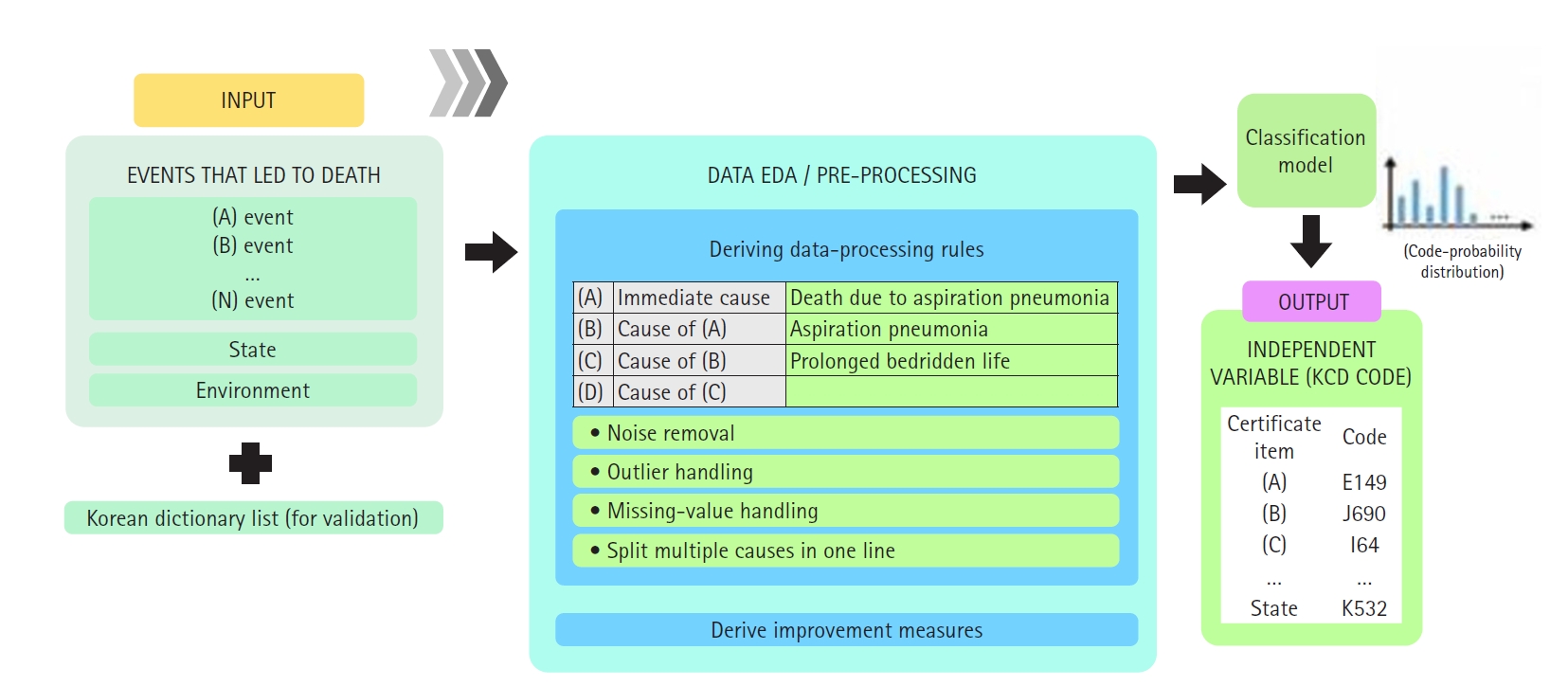| Seokmin Lee | 3 Articles |
|
[English]

Purpose
This study evaluated the feasibility and performance of a deep learning approach utilizing the Korean Medical BERT (KM-BERT) model for the automated classification of underlying causes of death within national mortality statistics. It aimed to assess predictive accuracy throughout the cause-of-death coding workflow and to identify limitations and opportunities for further artificial intelligence (AI) integration. Methods We performed a retrospective prediction study using 693,587 death certificates issued in Korea between January 2021 and December 2022. Free-text fields for immediate, antecedent, and contributory causes were concatenated and fine-tuned with KM-BERT. Three classification models were developed: (1) final underlying cause prediction (International Classification of Diseases, 10th Revision [ICD-10] code) from certificate inputs, (2) tentative underlying cause selection based on ICD-10 Volume 2 rules, and (3) classification of individual cause-of-death entries. Models were trained and validated using 2021 data (80% training, 20% validation) and evaluated on 2022 data. Performance metrics included overall accuracy, weighted F1 score, and macro F1 score. Results On 306,898 certificates from 2022, the final cause model achieved 62.65% accuracy (F1-weighted, 0.5940; F1-macro, 0.1503). The tentative cause model demonstrated 95.35% accuracy (F1-weighted, 0.9516; F1-macro, 0.4996). The individual entry model yielded 79.51% accuracy (F1-weighted, 0.7741; F1-macro, 0.9250). Error analysis indicated reduced reliability for rare diseases and for specific ICD chapters, which require supplementary administrative data. Conclusion Despite strong performance in mapping free-text inputs and selecting tentative underlying causes, there remains a need for improved data quality, administrative record integration, and model refinement. A systematic, long-term approach is essential for the broad adoption of AI in mortality statistics.
[English]
Purpose
This study aimed to analyze dementia-related death statistics in Korea between 2013 and 2023. Methods The analysis utilized microdata from Statistics Korea’s cause-of-death statistics. Among all recorded deaths, those related to dementia were extracted and analyzed using the underlying cause-of-death codes from the International Classification of Diseases, 10th revision. Results The number of dementia-related deaths increased from 8,688 in 2013 to 14,402 in 2023. The crude death rate rose from 17.2 per 100,000 in 2013 to 28.2 per 100,000 in 2023, although the age-standardized death rate declined from 9.7 to 8.7 over the same period. The dementia death rate is 2.1 times higher in women than in men, and mortality among individuals aged 85 and older exceeds 976 per 100,000. By specific cause, Alzheimer’s disease accounted for 77.1% of all dementia deaths, and by place, the majority occurred in hospitals (76.2%), followed by residential institutions including nursing homes (15.3%) in 2023. Conclusion The rising mortality associated with dementia, especially Alzheimer’s disease, highlights a growing public health concern in Korea. These findings support the need for enhanced prevention efforts, improved quality of care, and targeted policies addressing the complexities of dementia management. It is anticipated that this empirical analysis will contribute to reducing the social burden. Citations Citations to this article as recorded by

[English]
This study analyzed drug-induced death statistics in Korea between 2011 and 2021. Cause-of-death statistics data from Statistics Korea were examined based on the Korean Standard Classification of Diseases and Causes of Death and the International Statistical Classification of Diseases and Related Health Problems, 10th revision. In 2021, there were 559 drug-induced deaths, marking a 172.7% increase compared to 2011, which recorded 205 deaths. The rate of drug-induced deaths per 100,000 people was 1.1 in 2021, up 153.6% from 0.4 in 2011. The mortality rate for men aged 25−34 years and women aged 35−44 years each increased fourfold from 2011 to 2021: from 0.3 to 1.2 for the former and 0.3 to 1.3 for the latter. Of the drug-induced deaths in 2021, 75.0% (419/559) were due to intentional self-harm, and 10.4% (58/559) were accidental. The number of deaths attributed to medical narcotics in 2021 was 169, a 5.5-fold increase from 2011. The most commonly implicated drugs in these deaths were sedative-hypnotic drugs, benzodiazepines, and opioids. Sedative-hypnotic drugs and benzodiazepines were frequently involved in cases of intentional self-harm, while opioids and psychostimulants were more often associated with accidental deaths. The death rate from drug-induced causes is considerably lower in Korea than in the United States (1.1 vs. 29.2). However, the number of such deaths has increased recently. Since these deaths occur predominantly among younger age groups and are often the result of intentional self-harm, there is a clear need for systematic management and the implementation of targeted policies. Citations Citations to this article as recorded by

|
|

